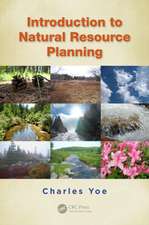Utilization of Residual Forest Biomass: Springer Series in Wood Science
Autor Pentti Hakkilaen Limba Engleză Paperback – 3 dec 2011
Din seria Springer Series in Wood Science
- 18%
 Preț: 1543.84 lei
Preț: 1543.84 lei - 23%
 Preț: 2062.76 lei
Preț: 2062.76 lei - 18%
 Preț: 1824.32 lei
Preț: 1824.32 lei - 24%
 Preț: 817.72 lei
Preț: 817.72 lei - 18%
 Preț: 1225.16 lei
Preț: 1225.16 lei - 18%
 Preț: 3288.92 lei
Preț: 3288.92 lei - 18%
 Preț: 948.29 lei
Preț: 948.29 lei - 18%
 Preț: 1222.31 lei
Preț: 1222.31 lei - 18%
 Preț: 2093.60 lei
Preț: 2093.60 lei - 18%
 Preț: 946.87 lei
Preț: 946.87 lei - 15%
 Preț: 643.34 lei
Preț: 643.34 lei - 18%
 Preț: 1122.87 lei
Preț: 1122.87 lei - 18%
 Preț: 1020.30 lei
Preț: 1020.30 lei - 24%
 Preț: 836.42 lei
Preț: 836.42 lei - 20%
 Preț: 569.49 lei
Preț: 569.49 lei - 15%
 Preț: 638.89 lei
Preț: 638.89 lei - 15%
 Preț: 636.30 lei
Preț: 636.30 lei - 15%
 Preț: 635.31 lei
Preț: 635.31 lei - 18%
 Preț: 878.05 lei
Preț: 878.05 lei - 15%
 Preț: 646.43 lei
Preț: 646.43 lei - 18%
 Preț: 1004.67 lei
Preț: 1004.67 lei - 18%
 Preț: 894.03 lei
Preț: 894.03 lei - 15%
 Preț: 641.53 lei
Preț: 641.53 lei - 18%
 Preț: 950.84 lei
Preț: 950.84 lei - 18%
 Preț: 783.35 lei
Preț: 783.35 lei - 15%
 Preț: 645.79 lei
Preț: 645.79 lei - 24%
 Preț: 880.81 lei
Preț: 880.81 lei -
 Preț: 388.13 lei
Preț: 388.13 lei - 18%
 Preț: 780.82 lei
Preț: 780.82 lei - 15%
 Preț: 529.13 lei
Preț: 529.13 lei
Preț: 658.70 lei
Preț vechi: 774.94 lei
-15% Nou
Puncte Express: 988
Preț estimativ în valută:
126.06€ • 131.12$ • 104.07£
126.06€ • 131.12$ • 104.07£
Carte tipărită la comandă
Livrare economică 15-29 aprilie
Preluare comenzi: 021 569.72.76
Specificații
ISBN-13: 9783642740749
ISBN-10: 364274074X
Pagini: 588
Ilustrații: XV, 568 p.
Dimensiuni: 170 x 242 x 31 mm
Greutate: 0.93 kg
Ediția:Softcover reprint of the original 1st ed. 1989
Editura: Springer Berlin, Heidelberg
Colecția Springer
Seria Springer Series in Wood Science
Locul publicării:Berlin, Heidelberg, Germany
ISBN-10: 364274074X
Pagini: 588
Ilustrații: XV, 568 p.
Dimensiuni: 170 x 242 x 31 mm
Greutate: 0.93 kg
Ediția:Softcover reprint of the original 1st ed. 1989
Editura: Springer Berlin, Heidelberg
Colecția Springer
Seria Springer Series in Wood Science
Locul publicării:Berlin, Heidelberg, Germany
Public țintă
ResearchCuprins
1 Introduction.- 2 Residual Forest Biomass as a Raw Material Reserve.- 2.1 Biomass Components of a Tree.- 2.2 Composition of Whole-Tree Biomass.- 2.3 Biomass of an Entire Stand.- 2.4 Forest Biomass Inventory.- 2.5 Quantity of Residue in Practical Logging Operations.- 3 Technical Properties of Residual Tree Components.- 3.1 Anatomical Structure of Residual Tree Components.- 3.2 Cell Dimensions in Residual Tree Components.- 3.3 Chemical Composition of Residual Tree Components.- 3.4 Basic Density of Wood and Bark in Residual Tree Components.- 3.5 Heating Value of Residual Tree Components.- 4 Recovery of Residual Forest Biomass.- 4.1 Harvesting Whole Trees.- 4.2 Relogging Slash from Cutovers.- 4.3 Continuously Progressing Swath Harvesters.- 4.4 Harvesting Stump and Root Mass.- 5 Comminution of Residual Forest Biomass.- 5.1 The Purpose of Comminution.- 5.2 The Techniques of Comminution.- 5.3 Energy and Power Requirement in Comminution.- 5.4 Position of Comminution in the Harvesting Schedule.- 6 Trucking Residual Forest Biomass.- 6.1 Transport-Technical Characteristics of Residual Biomass.- 6.2 Improvement of Bulk Density by Compaction.- 6.3 Trucking Unlimbed Timber.- 6.4 Trucking Unprocessed Logging Residue.- 6.5 Trucking Comminuted Biomass.- 6.6 Alternatives to Trucking.- 7 Examples of Biomass Harvesting Systems.- 7.1 Whole-Tree Chipping Systems.- 7.2 Systems for Chipping Slash.- 7.3 Systems for Integrated Recovery of Crown Mass and Conventional Timber.- 7.4 Systems, for Harvesting Stump and Root Mass.- 8 Utilization of Residual Forest Biomass.- 8.1 Use of Chips as a Solid Fuel.- 8.2 Use of Residual Biomass for Pulp and Paper Products.- 8.3 Use of Residual Biomass for Panel Products.- 8.4 Use of Residual Biomass as a Feedstock for Chemicals.- 8.5 Use of Residual Forest Biomass for Fodder.- 8.6 Upgrading Residual Forest Biomass.- 9 Ecological Consequences of Residue Removal.- 9.1 Effect of Residue Removal on Nutrient Balance.- 9.2 Effect of Residue Removal on Regeneration and Growth.- 9.3 Effect of Residue Removal on Forest Health and Environment.- 9.4 Returning Nutrients to Forest Soil.- Scientific and Common Names of Tree Species.- Equivalents and Conversion Factors.- References.








